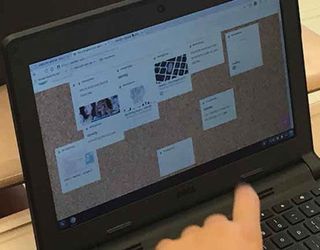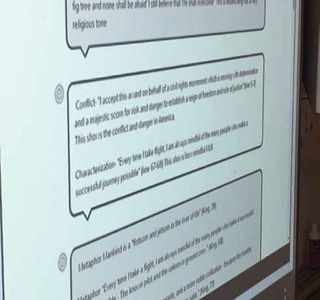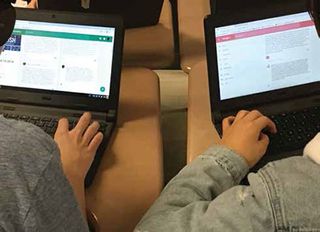ALL WRITING CAN BE BETTER THROUGH TECHNOLOGY
Picture this: you assign student writing, provide time for work and revision, and dedicate hours to feedback for growth. Yet students are still making the same mistakes. Sound familiar?
With collaborative, real-time, and cloud-based technology tools, teachers can go beyond traditional teaching methods with new ways to help students improve their writing.
FORMATIVE FEEDBACK

In addition to giving summative feedback when writing is turned in, technology can provide feedback throughout the learning process. In both Google Docs and Office 365, teachers can leave real-time comments on students’ work while they’re writing. We can check in on all of our students’ work and give specific feedback and deepen what they’re learning before they submit their work. Whether it’s a few quick words or in-depth comments, this strategy helps students fix mistakes, build on their strengths, and continue to grow so that their final product is the best it can be.
ATTENTION TO AUDIENCE
When students write for their teachers, the learning ends when they turn in the assignment. Teachers provide feedback on the completed work and return it filled with comments to help students understand and grow on future assignments. By changing the audience, we can also change the feedback process. An audience of peers, a class, a school, or even the world can provide more feedback than any one teacher ever could. For example, use a community tool like Google Classroom’s stream, Edmodo, or Twitter to give students a forum to read and respond to each other’s writing and ideas. Teach students to provide strong, constructive feedback and use these tech tools to increase feedback exponentially. Students can help each other with the formative feedback process, reducing the time teachers need to spend making simpler, routine comments so they can spend more time working with students face-to-face and providing more meaningful feedback.
COLLABORATIVE GROWTH
Teachers can use cloud-based tools to provide ongoing support throughout the writing process.

Formative assessment tools like Pear Deck and Socrative allow students to share their writing anonymously for review as a class or by the teacher. Students can submit anything from a thesis statement to a paragraph draft to share with the class, without the pressure of signing their name to work in progress. Written feedback from teachers and students matters, but sometimes it’s actual discussion that helps drive student growth. Sharing student models and examples with a formative tool—or even shared documents—allows students to learn from each other’s mistakes and triumphs and to grow together.
REVISE AND TRACK CHANGES
If students are constantly improving their work, it’s important for teachers to be able to have an understanding of their growth. When a student revises based on peer or teacher comments, we need to know. Student reflection about their revision is also helpful so teachers can understand students’ decisions throughout the writing process. Both G Suite and Office 365, as well as most of the apps from these tech giants, track changes and revisions live. When teachers can see these revisions, we can see the learning progress and growth, so not only do our students do better, but we understand why and how. Add in a Google Form or other data-collection tool to have students reflect on their progress and understanding too.
SHARE RESOURCES

Sometimes students simply need more help or more immediate guidance than teachers or peers can provide. Writing is a complex task, but technology provides countless resources to help our students. Consider sharing videos, articles, or tutorials with your students to help them overcome common challenges, deal with their writing struggles, and gain a better understanding of grammar rules or techniques. Whether you create your own or curate from sites like Khan Academy, Purdue’s Online Writing Lab, or even YouTube, you’re giving students opportunities to learn more.
PICTURE THIS
Now picture this: students have turned in a recent writing assignment and you know that they were successful because you read and commented along the way. A quick skim and a few comments helped everyone do better. You were also able to catch and respond to the major issues along the way. Using technology and formative assessment strategies, students learned from you and from each other, keeping the learning going throughout the process.
It’s time for both students and teachers to work smarter, not harder, by using technology so all students can succeed and grow in their writing.
Adam Schoenbart is a high school English teacher at Ossining High School (NY), Google Education Trainer, and EdD candidate in Educational Leadership.
Tech & Learning Newsletter
Tools and ideas to transform education. Sign up below.











